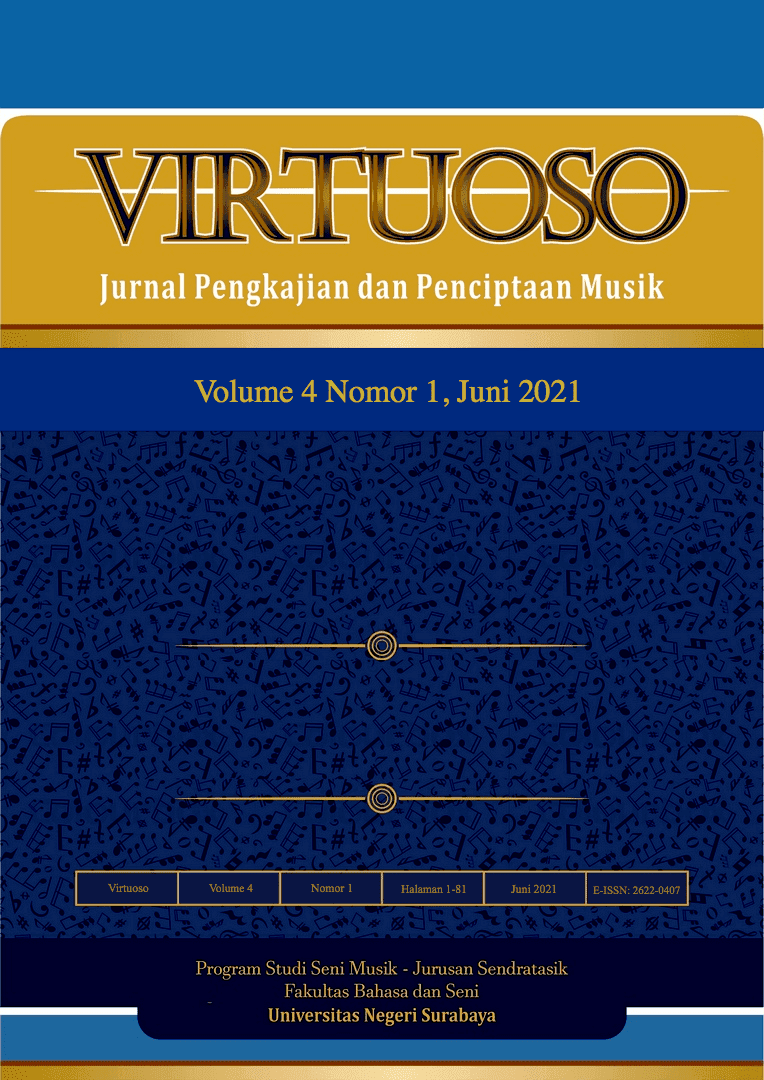Optimalisasi Kompetensi Primavista Mahasiswa Instrumen Pokok Piano Melalui Metode Drill
Main Article Content
Abstract
Every musical instrument that is taken at the college "demands" students to be mastery learning, in both theoretical and practical aspects, as well as possible. However, in the process, there are obstacles that often arise. As in learning the Piano Major course. Based on observations in class, students are constrained in terms of primavista. With the character of the piano score that is consisting of two staves, students are constrained to coordinate their cognitive processing when reading piano scores, with the application of their ten fingers when playing the piano. This study discusses the primavistalearning of piano with the drill method. The type of research conducted was qualitative research, which was conducted in Music Arts Study Program, Universitas Negeri Surabaya.Based on the results, there was a significant improvement in the students' ability to apply the music notation they had read primavistly. In the pre-test session, most of the students' scores were below 40%. However, when the post-test session was conducted, the results of the work shown were very satisfactory. All students were able to achieve scores above 70%. Based on these results, it can be stated that the drill method has succeeded in optimizing the development of primavistaabilities of piano students. It is hoped that this method can be used routinely in piano classes so that students' primavistaabilities can be further honed.
Downloads
Article Details

This work is licensed under a Creative Commons Attribution-NonCommercial-ShareAlike 4.0 International License.
The copyright of the received article once accepted for publication shall be assigned to the journal as the publisher of the journal. The intended copyright includes the right to publish the article in various forms (including reprints). The journal maintains the publishing rights to the published articles.
References
Arikunto, Suharsimi. 2011. Penelitian Tindakan 2010, Aditya Media, Yogyakarta, Cetakan keempat.
Banoe, Pono. 2003. Kamus Musik. Yogyakarta: Kanisius
Chaplin, J. P. (1968). Dictionary of psychology.
Djohan. Psikologi Musik. Best Publisher, Yogyakarta, Cetakan ketiga, 2009.
Florentinus, Totok. 1997. Pengembangan Instrument Pengukuran Kemampuan Solfeggio
Hintzman, D. L. (1978). The psychology of learning and memory. Freeman.
Jiang, X. (2019, August). Reflections on Practical Teaching of Piano Course in Music Major of Local Higher Normal Colleges. In 5th International Conference on Arts, Design and Contemporary Education (ICADCE 2019) (pp. 628-630). Atlantis Press.
Khodijat, Latifah. 2004. Istilah-Istilah Musik. Jakarta: PT. Gramedia
Kaestri, V. Y. (2015). Perpaduan Nada?nada dalam Perspektif Harmoni dan Aplikasinya Terhadap Mahasiswa. PROMUSIKA: Jurnal Pengkajian, Penyajian, dan Penciptaan Musik, 3(2), 149-162.
Kristina, Maria. 2012. Penerapan Metode Primavista Bagi Mahasiswa Praktek Instrumen Mayor (PIM) VI Piano di Jurusan Pendidikan Seni Musik. Universitas Negeri Yogyakarta: Skripsi Tidak Diterbitkan
Magara, Ardi; Nurulloh, Achmad; Pangesti, Fransiska H. Perbandingan Kecepatan Berpikir dan Primavista Anak Melalui Kajian Instrumen Flute. Universitas Negeri Yogyakarta: Skripsi Tidak Diterbitkan
Nursalim, Mochamad dkk. 2007. Psikologi Pendidikan. Surabaya: Unesa University Press
Oemar, Hamalik. 2004. Psikologi Belajar Mengajar. Bandung: Sinar Baru Algensindo.
Pekerti, Widia, dkk. 2008. Metode Pengembangan Seni: Edisi Kesatu. Jakarta: Universitas Terbuka
Skinner, C. E. (1945). Educational psychology, Rev.
Sudjana, Nana dan Ibrahim. 2001. Penelitian dan Penilaian Pendidikan. Bandung: Sinar Baru Algensindo
Sukardi, S. (2019). Peningkatan Keterampilan Praktik Siswa pada Pekerjaan Memasang Kosen melalui Teknik Make A Match. Paedagogie, 14(1), 15-20.
Susilana, R. (2014). Pendekatan saintifik dalam implementasi kurikulum 2013 berdasarkan kajian teori psikologi belajar. Edutech, 13(2), 183-193.
Tawangsasi, U., Milyartini, R., & Virgan, H. (2019, February). Student-Centered Approach in Piano Study for Teenagers: Is it possible?. In International Conference on Arts and Design Education (ICADE 2018) (pp. 270-273). Atlantis Press.
Thuntawech, S., & Trakarnrung, S. (2017). The ideal characteristics of higher education music institutes in 21st century Thailand. Malaysian Journal of Music, 6(1), 30-49.

